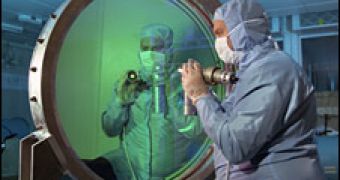The Vulcan laser, currently the most powerful in the world, was used recently to test future nuclear fusion reactor concepts. During the experiments Vulcan was able to heat matter to a temperature of 10 million degrees Celsius, hotter than the surface of the Sun which is averaging about 5,500 degrees Celsius. The released energy was concentrated on a spot measuring only a few thousandths of a meter for a couple of fractions of a second.
Now, UK researchers want an even more powerful laser facility, which will further advance the study of laser fusion feasibility as future energy source. "Hiper (High Power laser Energy Research) is a proposed, very large-scale facility and so we have to check that our understanding is correct", says Professor Peter Norreys from the Rutherford Appleton Laboratory.
Nuclear fusion is often regarded by researchers as a means of producing high amounts of energy without heavily polluting the environment. Nuclear fusion is basically the reaction that is powering the Sun. Hydrogen, universe's most abundant and simplest element, is fused at high temperatures in order to create heavier elements: helium, lithium and so on. At the same time, massive amounts of energy are being released into the surrounding medium, which can then be harnessed and converted into electric energy.
As opposed to nuclear fission, the reaction used to split uranium in nuclear power plants and nuclear fission weapons, nuclear fusion only produces byproducts with relatively low radioactivity. Nuclear fusion occurs naturally in the Sun's core under the action of powerful gravitational fields. On Earth the means to reproduce such conditions are unavailable, but nuclear fusion would occur nonetheless if matter were heated to about 100 million degrees Celsius.
To do so, researchers need extremely powerful laser facilities, such as Hiper. It is hoped that Hiper could continue the research initiated at the National Ignition Facility at the Lawrence Livermore National Laboratory, which should demonstrate energy production through nuclear fusion by 2012.
The technique is now competing with another fusion experiment which is using powerful magnetic field to fuse hydrogen and confine the plasma.
The amount of energy released during the Vulcan experiment was about 1,015 watts on a spot ten times smaller than the width of a human hair and lasted for only one trillionth of a second, heating the sample to 10 million degrees Celsius similar to the temperature of a supernova explosion.
"We wanted to understand the basic interaction of matter with these laser pulses", said Norreys.
"Efficient coupling of the laser energy to the target is crucial for fast ignition fusion, and is one of the main questions on which the design of? Hiper depends", said Dr Jonathan Davies from Instituto Superior Technico, who also participated in the study.

 14 DAY TRIAL //
14 DAY TRIAL //